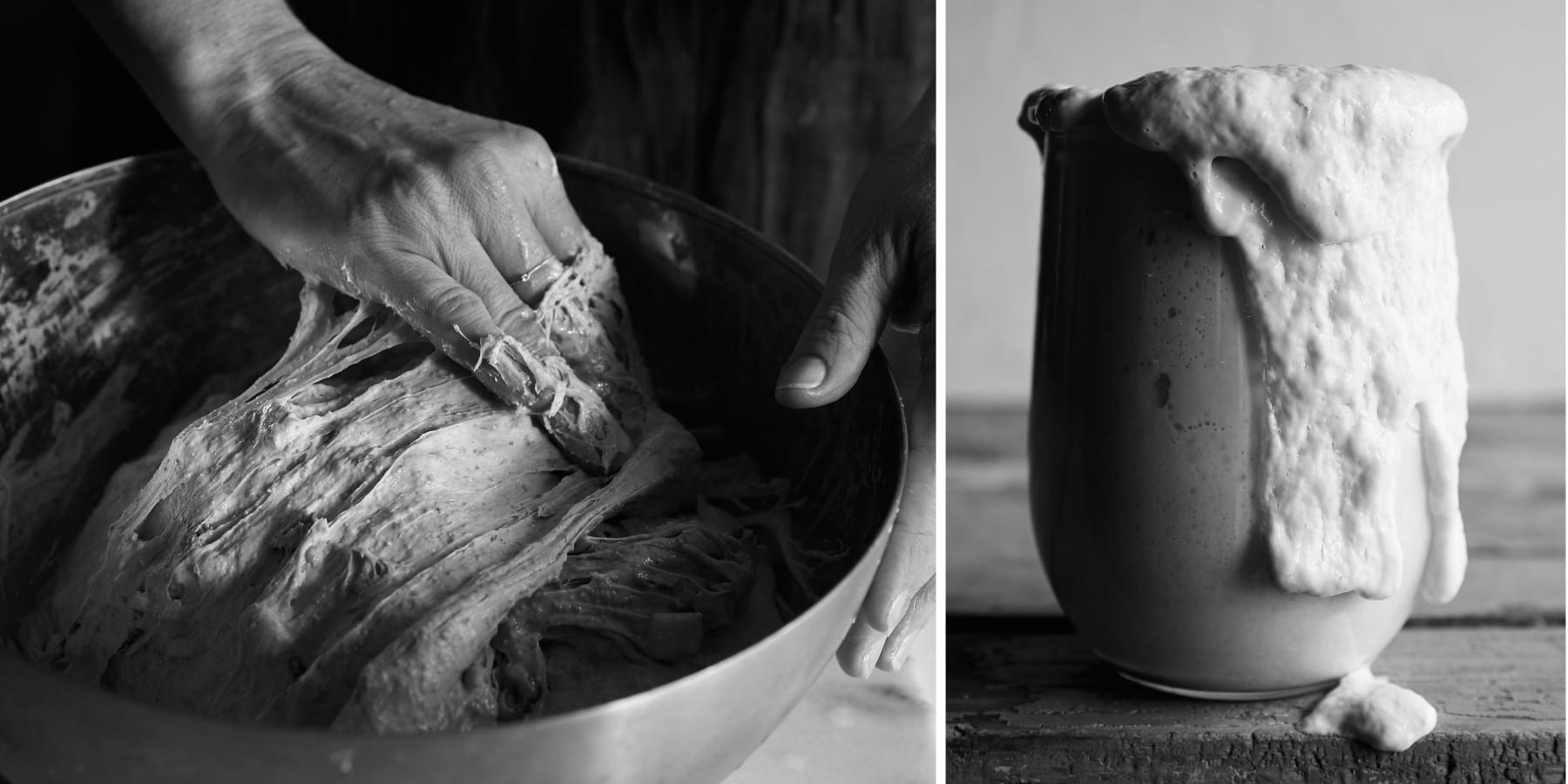An interesting way to create a starter from scratch involves using raisins to make yeast water. Sarah Owens of BK17 Bakery in New York and Kentucky call the resulting starter the ‘mother’ because it will give birth to many different recipes. The most important thing to remember is that sourdough is a living being. Although there are as many ways to maintain a starter as there are bakers, a simple feeding schedule will help you maintain your starter for years to come. Baking only occasionally? Simply tuck it back into the refrigerator after a feed and allow it to slip into cold dormancy. It will be ready to awaken and leaven bread again whenever you are.
Starter Maintenance
To perform a feeding, simply discard half the amount and add water and flour in parts equal to or greater than weight of remaining starter. For example, if you have 100 grams of starter left after you’ve discarded half, add at least 100 grams water and 100 grams flour. It’s important not to starve your starter with skimpy feedings, but it is okay to add more water and flour to bulk it up when planning a big batch of baking. If you are keeping your starter in refrigerator for longer than a few days, it is preferable to give it two feedings at room temperature before making leaven or mixing dough.
Maintaining a sourdough starter culture is the soul of bread baking and a relatively simple affair if you learn the clues of fermentation and how to react to them accordingly. No single feeding or batch of bread will perform exactly the same as the last, due to the many variables that affect fermentation, including time, temperature, atmospheric humidity, and the type of flour used. This is the glory and joy of baking with natural leavening. Over time, you will intuitively learn to better gauge starter and dough. Engage your sense of smell, as well as sight, to note the maturity of the starter and when it is ripe and ready to leaven bread: it should smell fruity and slightly acidic and have recognizable bubbles present on the surface.
recipe 
yields
Adapted from Sourdough with permission of Roost Books
An interesting way to create a starter from scratch involves using raisins to make yeast water. I call the resulting starter the “mother” because it will give birth to many different recipes.
2 1-liter lidded glass or ceramic containers
690 grams filtered water, separated
150 grams granulated sugar
65 grams raw honey
225 grams organic raisins
180 grams bread flour, separated
I like to keep about 150 grams to 300 grams starter on hand. If you bake less, you may only need half of that. Always refresh (feed) your remaining starter after using it in a recipe with equal amounts of each water and flour in proportion to the starter. If you are only an occasional or weekend baker, the refrigerator is the best home for your starter, but it will need to be fed twice before it will be strong enough to leaven bread dough. If you need to discard some of the starter to make room for a feeding, consider using it in a recipe that uses starter as an ingredient rather than a leavening agent.
ingredients
Chef’s Note:
steps
- In saucepan, combine 570 grams water with sugar. Set over low heat just until dissolved. Cool.
- Once cool, stir in honey and place in one container, along with raisins. Seal and place in warm location (at least 70 degrees) in your kitchen.
- Thoroughly shake mixture several times daily and pop top periodically to allow for adequate air exchange over the next 5 to 7 days. After 3 or 4 days (depending on ambient temperature of kitchen), you’ll begin to smell alcohol. The lid will pop when opened, releasing carbon dioxide as by-product of fermentation. This means you are on your way to a happy mother! Leave jar loosely covered with lid at this point, allowing mixture to “breathe.”
- After 6 or 7 days, you should observe bubbles actively rising to surface. This means yeast water is ready. Add 60 grams yeast water to 60 grams bread flour in second container (this jar will house starter). Stir until thoroughly mixed, and leave loosely covered with lid at room temperature for 8 hours or overnight.
- After initial mixing, small bubbles will indicate signs of life. Add remaining 120 grams water and remaining 120 grams flour, position lid, and allow to ferment at room temperature for another 8 hours.
- Now that you have your own sourdough mother, keep it alive by feeding equal parts starter, flour, and water by weight (See “Starter Maintenance” for more detailed information on feedings). After several more feedings, drop 1 tablespoon starter in glass of water. If it floats instead of sinks, your starter is ready to leaven bread. Note: Once fed, starter will double in size. Keep it in a container that will accommodate this expansion.
share
- Baker and author Sarah Owens of BK17 Bakery in Brooklyn, New York and Louisville, Kentucky






